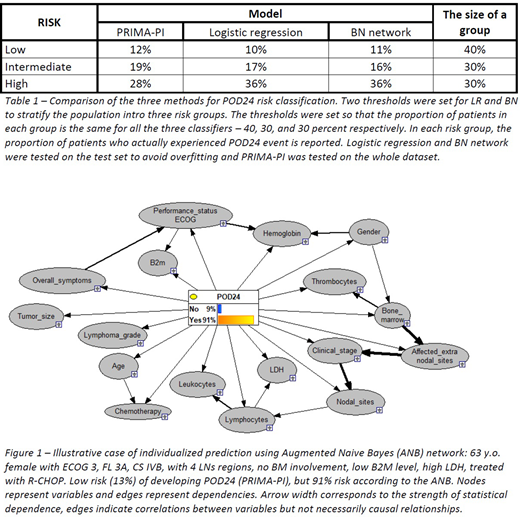Background: Twenty percent of patients (pts) with high-tumor burden follicular lymphoma (FL) develop progression/relapse of disease within 24 months of frontline immune-chemotherapy (POD24). Those ultra-high-risk cases are at 50% risk of dying within 5-years since the POD event. Unmet need is to identify such pts at the time of initial treatment. The traditional approach used for building predictive scores (such as FLIPI, PRIMA-PI) is multivariable logistic regression (LR). LR is the tool of choice in case of many predictors (continuous or categorical) and a single binary (yes/no) outcome. Bayesian network (BN) offer an alternative strategy which may overcome several drawbacks of LR (risk of overfitting, missing data handling, problems of odds ratio interpretation), brings more insight into the complex relations among the variables, and offer an individualized prediction.
Aim: The goal was to build a model to predict the risk of POD24 from the parameters known at diagnosis and compare LR to BN approach.
Methods: The study (ClinicalTrials.gov No NCT03199066) comprised 1394 FL (grade I-IIIA) patients from the Czech Lymphoma Study Group registry treated with frontline rituximab-containing regimen and diagnosed between 10. 4. 2000 and 28. 12. 2016. The following parameters were analyzed: gender, age at diagnosis, clinical stage, lymphoma grade, no. of LNs regions, bone marrow involvement, no. of extranodal localizations, longest tumor diameter, systemic symptoms, performance status, LDH, beta-2-microglobulin, hemoglobin, and leucocyte, lymphocyte, and thrombocyte counts, induction regime, radiotherapy, ASCT, maintenance application, response to treatment, and OS, PFS and POD24 as outcome parameters. POD24 was defined as relapse, progression, change of therapy for 24 months since the induction started. Only parameters known at diagnosis were used for the prediction of POD24.
Results: The median age was 59 yrs (range 26-89 yrs) with female predominance (59.2%), advanced disease stage (III/IV) was seen in 85.9% of the cases and FLIPI risk groups distribution was as follows: low (18.8%), intermediate (30.9%) and high (50.3%). The most frequent regime used was R-CHOP (76.8%), followed by R-CVP (12.4%), R-bendamustine (4.7%), intensive protocols (3.3), and fludarabine-based (2.8%). Consolidative IF-radiotherapy was applied in 5.1% and up-front ASCT in 2.9% of the pts. Maintenance immunotherapy was given in 67.1% of the pts. Response to therapy was known in all but 28 pts (98%) with CR/CRu 67.9%, PR 26.6%, SD 1.8%, and PD in 3.2% of the cases. After a median follow-up of 7.64 yrs, 484 (34.7%) of the pts progressed or relapsed and 316 (22.6%) have died. POD24 was recorded in 266 (19.0%) of the pts. The 5-year OS reached 86.4% and 5-year PFS 64.2%.
LR model (PFS) building strategy included testing for significance as this model performed better than the model with all parameters. Overfitting was prevented by splitting the data into training (75%) and testing (25%) set. The performance of the model was assessed using the AUC criterion computed on the ROC curve. The LR model reached AUC of 0.69, and at 80% specificity, it reached about 51% sensitivity. Next, the BN (Augmented Naïve Bayes Classifier) was trained. Links of all predictors to POD24 were forced and all links to age and gender were forbidden, otherwise the network structure was inferred from the data. The performance of the BN was similar to the LR - AUC of 0.67 and about 50% sensitivity at the specificity of 80%. Both these models were compared to the standard PRIMA-PI risk classifier and were found to better stratify the population into risk groups (Table 1). An example of a patient is presented who was low-risk according to PRIMA-PI but actually experienced the POD24 event. The BN estimated the probability of the event to 91% (Figure 1).
Conclusion: Lymphoma-related death following POD24 remains the most frequent cause of mortality in FL patients. BN modelling is a non-inferior prognostic tool compared to LR in term of POD24 prediction. Unlike LR, it also allows visualisation of complex relations among the predictors and individualized prediction of the patient's POD24 risk, even if some of the predictors are unknown. Both "ad hoc" trained LR and BN were found to better stratify the population into risk groups with respect to POD24 event than the traditional PRIMA-PI score.
Acknowledgement: MZ Czech Republic DRO grant (FNOL, 00098892).
Procházka:F. Hoffmann-La Roche AG: Consultancy, Honoraria; Takeda Pharmaceuticals, Inc: Consultancy, Research Funding. Belada:Roche: Consultancy, Membership on an entity's Board of Directors or advisory committees, Other: Travel expenses, Research Funding; Janssen: Consultancy, Membership on an entity's Board of Directors or advisory committees, Research Funding; Gilead: Consultancy, Membership on an entity's Board of Directors or advisory committees, Other: Travel expenses, Research Funding; Celgene: Research Funding; Takeda: Consultancy, Membership on an entity's Board of Directors or advisory committees, Other: Travel expenses, Research Funding. Trněný:Janssen: Consultancy, Honoraria, Other: Travel Expenses; Gilead: Consultancy, Honoraria, Other: Travel Expenses; Takeda: Consultancy, Honoraria, Other: Travel Expenses; Bristol-Myers Squibb Company: Consultancy, Honoraria, Other: Travel Expenses; Amgen: Honoraria; Abbvie: Consultancy, Honoraria, Other: Travel Expenses; Roche: Consultancy, Honoraria, Other: Travel Expenses; MorphoSys: Consultancy, Honoraria; Incyte: Consultancy, Honoraria; Celgene: Consultancy.
Author notes
Asterisk with author names denotes non-ASH members.


